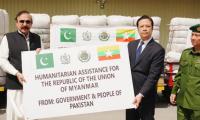According to Muhammad Ali, a resident of Hussain Hazara Goth, there are Hazara students in public and private universities but their numbers don’t reflect the true proportion of young Hazaras living in the city.
“Usually they can’t even afford public universities. If they can it is difficult for the families to survive if the earned money is put into education,” said Ali.
An activist, Muhammad Shahbaz*, who is an advisor at the Hazara Yakhjeti Forum, opined that the issues of Hazara community have been confined to sectarian violence and no one looked beyond them.
“In Karachi, the standard of schools and colleges near Hazara-dominated localities is highly deplorable,” he said. “Though we haven’t yet taken any initiative to raise the issue with the provincial government but looking at the state of the things, it’s highly unlikely that they would be of any help for us.”
Shahbaz said his community realised the true value of education and before migrating to Karachi a number of people were studying in well-reputed institutions. “We are highly concerned for our children here. Without education, their future is bleak,” he said.
Registration
Another major issue faced by the Hazara community is obtaining the Computerised National Identity Card (CNICs).
When asked about it, Shahbaz told The News that the community was distraught over not being issued their CNICs. “Even if we are able to get it, it is handed over to us in a highly insulting manner,” he said. “When we visit the Nadra offices wearing our traditional shalwar qameez, the officials suspect us to be Afghans. When the CNICs are finally issued, they are usually blocked and after countless visits to the Nadra franchise, the officer finally asks for a bribe between Rs10,000 and Rs22,000.”
Shahbaz said his forum had filed a case in the Sindh High Court on February 28th this year and the respondents included Nadra chairman, passport office chairman, Sindh home department, SSP Sindh and also the ministry of interior.
“It is not just a question of our identity but our financial prospects are also attached to it,” he said. “It is an elephant in the room which can’t be ignored.”
Political representation
The most prominent voice for the Shia community these days, the Majlis-e-Wahdat-e-Muslimeen (MWM) rose to surface on the shoulders of Hazara community’s protest after the bomb blast on Alamdar Road which claimed more than 90 lives.
However, the community itself is divided over the party’s usefulness to the community in raising their problems with the relevant authorities and getting them resolved.
A significant number of Hazaras unequivocally support the party on grounds that it gives them a voice on bigger platforms and has emerged as a significant political entity in the city’s politics, But Akbar believes there is a section, including him, which also perceives the MWM to be engaged in the politics of “Muk Muka”.
“Why is it that after every sit-in organised by the party on the pretext of Shia solidarity, the deal between the MWM and the government is never made public?” he asks.
The KU student himself too remains skeptical of the politics of the MWM and believes that it is not the answer to the woes of Hazara community.
“Contrary to what the party might claim to do, its politics further marginalise our community,” he said.
On the other hand, a representative of the Imamia Students Organisation, Saqib Mehdi*, also an ethnic Hazara, believed that the MWM had achieved in calling attention to the problems faced by Shia community.
“It has broken the political apathy towards Shias and Hazaras in general and this is a credit which the MWM deserves,” he said.
*Names have been changed to protect privacy
Workers washing 300 KWP solar PV system after its installation on December 4, 2022. — APPThe federal government was...
The Sindh High Court building in Karachi. — Facebook@sindhhighcourt.gov.pk/FileThe Sindh High Court has dismissed...
Sindh Police Chief Ghulam Nabi Memon chairs a meeting at the Central Police Office on December 13, 2024. —...
Saylani Welfare International Trust building seen in this image. — saylaniwebproject/FileThe non-profit Saylani...
MOU signing ceremony between the IBA’s Center for Executive Education and the Pakistan Airports Authority’s Civil...
An aerial view of the commercial district of Pakistan's port city of Karachi. — AFP/FileThe Kingdom of...







